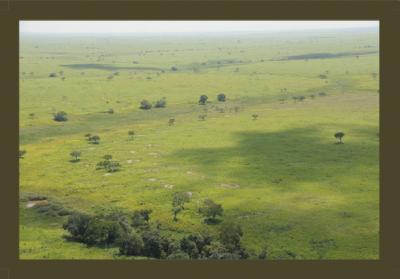|

Spot any lions to extrapolate?
The Selous Game Reserve in southeastern Tanzania is very large – about 47,500 km2. Supposedly home to a great wealth and diversity of wildlife, it has also been identified as one of the most important lion “strongholds” in Africa. It has also recently become known as a massive elephant poaching slaughterhouse.
A scientific paper by Riggio et al (2013) estimated a lion population of no less than 7,644 individuals in the Selous region, with 4,953 in the “protected” areas . The estimate was made by remote sensing of “suitable habitat” and then extrapolating lions into the area.
Another estimate was made by Brink et al (2012) who estimated a total of 4,300 individuals (confidence levels indicate a range between 1,700 and 6,900 individuals). The estimate was made by ground surveys over 459 km2 (less than 1% of the total area) and then extrapolating lion densities across the rest of the Selous. The researchers actually only encountered 20 lions during their ground surveys…
Brink et al used a “call-up” method, an accepted means of counting lions in an area. Calls of a buffalo in distress are made over loudspeakers, and lions that approach the vehicle are then counted, sexed, aged and photographed. Brink et al assumed that lions “heard” the calls from a maximum of 1.5 km away, and assumed they sampled lions in that area. Other researchers working in other locations assumed lions heard the calls from 2.5 km away or even 3.5 km away.
The importance of the response radius is that it greatly affects the estimated lion numbers. Brink et al estimated an average of 0.06 adult lions/km2 in the Selous, but if lions responded from further away, the estimates might have gone down to 0.02 or 0.01 adult lions/km2. Meaning that instead of 2,850 adults, there could only have been 950 or perhaps even 475 adult lions in the Selous.
So, via different methods and using different assumptions, all we can say is that the Selous contains anywhere between 475 and 4,953 lions.
Now ask yourself if those sorts of lion “population estimates” are good enough to guide any conservation programme for a species in rapid decline?
That question is all the more relevant because over 80% of the Selous is divided up into trophy hunting areas, and lions are shot there in significant numbers each year.
Brink et al did make a very significant observation in this regard. In 1997, previous studies showed that the adult male:adult female ratio in the area was 1:1.28. However, by 2009, that ratio had declined by 234% to 1 male lion to 3 female lions, suggesting significant overutilization by trophy hunters. Similarly skewed sex ratios in or near trophy hunting areas have also been observed in Cameroon, Zimbabwe, Zambia, etc.
It is high time that we cease to rely on population projections and radical extrapolations to estimate lion numbers remaining in Africa. This is a species in dire straits that is reduced in population numbers by a diversity of factors including loss of prey and habitat, diseases, conflict with humans and their livestock and trophy hunting. It is high time we stopped being complacent and gathered some realistic lion numbers to scientifically guide future conservation programmes to at least stabilize what lions are left in Africa.
This will cost money, but we can no longer make these sorts of stabs in the dark when talking about population numbers of an increasingly endangered species. Especially when adult and subadult males of that species continue to be commercially utilized via trophy hunting.
Picture credit: http://www.panoramio.com/photo/95423814
|




